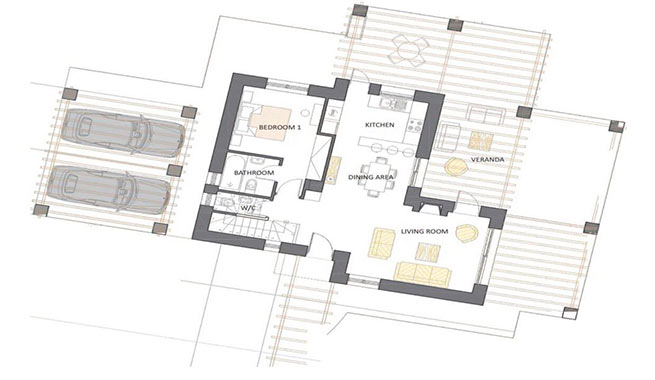The Independent Revenue Service (AADE) has announced that it has extended the E9 filing deadline by 1 month:
“By the decision of the head of AADE, Georgy Picilis, the deadline for submitting real estate data declarations for 2023 by individuals and legal entities, as well as legal entities of property owners, has been postponed until July 31, 2023. The purpose of the postponement is to make it easier for taxpayers to consistently meet their obligations while ensuring the smooth completion of the filing process for these returns.” AADE reports.
You can submit a declaration form E9 or check its status by link
Attention:
Declaration E9 ndressed only in electronic form through the appropriate Appendix “Declaration E9 / ENFIA» on the AADE website. To do this, you need to have access to the online services of the taxisnet system. The obligation to submit an E9 declaration does not expire after years of limitation, and late submission of data entails fines.
E9 – what codes indicate the correct identity of the property
The codes we need to pay attention to when filling out the Real Estate Data Declaration (E9) form were published by the Independent State Revenue Office (AADE) decision A.1175/5.8.2021 (Government Gazette: 3706 B’/11-8- 2021). More specifically, according to the decision of the AADE manager, those elements that constitute the tax identification of the property and affect the correct calculation of tax for the needs of the ENFIA certificate are determined, namely:
Elements that make up the tax identification of property and affect the correct calculation of tax
I. Table 1 of the real estate data declaration (E9)
- Details of the property (columns 3, 4, 4a, 5, 6, 7 and 28. In particular: prefecture, municipality or municipality, municipal or communal area, street number, other blocks of the building, street facades and number of facades),
- APAA indication (column 26),
- category of property, floor, area, year of construction, as well as the area of the site (columns 9, 11, 12, 13, 14 and 18),
- type of right, percentage of joint ownership and, in the case of usufruct, year of birth (boxes 15, 16, 17, 19, 20 and 21),
- special conditions, if the corresponding box is filled in (column 10),
- electrification of a property in an unfinished and empty building (columns 30 and 32), g. special category in which the property is included, provided that the corresponding column is completed (column 32)
- category of use of the building / site, provided that the corresponding column is filled in (column 33),
- details of the site, where necessary, and in each case in private houses and special buildings.
II. Table 2 declaration of real estate data (E9)
- Details of the address of the property (columns 3, 4, 4a, 5 and 6. In particular: prefecture, municipality or municipality, municipal or communal area, street number or location, street front),
- distance from the sea (column 7),
- land subject to expropriation, provided that the relevant column or irrigated area is completed (columns 8 and 9),
- field area according to its category (columns 10, 11, 12, 13, 14, 15 and 16),
- area of buildings located on the site, according to their category (columns 17a, 17b, 17c and 17),
- special land use (column 29),
- type of right, percentage of joint ownership and, in the case of usufruct, year of birth (boxes 18, 19 and 20),
- the special category in which the property belongs, provided that the corresponding column is filled in (column 26),
- land use category, if the corresponding column is filled in (column 28),
- field data where needed.
Do not affect tax identification
The following data is not a real estate tax identification as it does not affect the correct calculation of EN.F.IA.
- Property identification number (ATAK) and property code (KAEK) (columns 1 and 27 of tables 1 and 2),
- postcode and building block number (column 25 of tables 1 and 2 and column 8 of table 1), c. front length (column 29 of table 1),
- quantity of electricity/supply of the facility (column 31, table 1 and columns 21 and 22, table 2).
In particular, the total area of buildings on the plot (column 22 of Table 1) is excluded from the elements that make up the tax identity of the property, due to the inability of the notary and the mortgagor/head of the cadastral office to diagnose the fidelity of the declared.
What else to pay attention to:
- In cases where the certificate identifies what is stated in the notarial deed, the prefecture, municipality or community, municipality or municipal area in which the property is located, and the street, number or location is different, the certificate is considered correct if it is clear to the notary that it is the same property. The address of the property is considered correct regardless of whether it is indicated in accordance with Law 2539/1997 (A’ 244) (KAPODISTRIAS) or Law 3852/2010 (A’ 87) (KALLIKRATIS).
- If they do not match what is indicated in the notarial deed, prefecture, municipality or community in which the property is located, then the certificate is considered not attached. A certificate that contains a floor difference is also considered not attached. A certificate that cumulatively differentiates by type of property right and percentage of joint ownership of real estate is also considered not attached. If there is a difference in either the type of property right or the percentage of joint ownership of the property, the certificate is considered inaccurate.
- In case the property has more than two facades and in the EN.F.IA. only two of them are specified, the certificate is considered valid if it does not affect the Price of the Zone or the taxable value of the property. The same applies to cases where a site or building was listed on property data declarations for all or some years with two facades while it has more or is blind, unless the property’s facade, which was not claimed to have an impact on EN.F.IA. in the direction of increase.
- The certificate is considered valid if for all or some years it has been indicated as a property category a detached private house, instead of a building property category. In addition, the certificate is considered valid if the land, plot or building has been listed for all or some of the years with an area greater than the final registration in the land registry, or, if there is no such area, with an area greater than its title or, if there is no title, the area is larger than its actual state, and also in the case of including vertical ownership as an independent plot, provided there is no tax loss.
- It is considered correct to indicate on the certificate a different year of construction for all or some of the years, only in cases where the EN.F.IA is not reduced for this reason.
- The certificate is considered correct if a different year of birth of the usufructuary is indicated for all or some of the years, only in cases where the EN.F.IA is not reduced for this reason.
Description of the declaration provided by the publication greekdom







More Stories
Greece: growth in deposits from households and businesses in March 2024
How much will it cost a Greek family to celebrate Easter?
EU employment record: Greece "stuck" in a low position